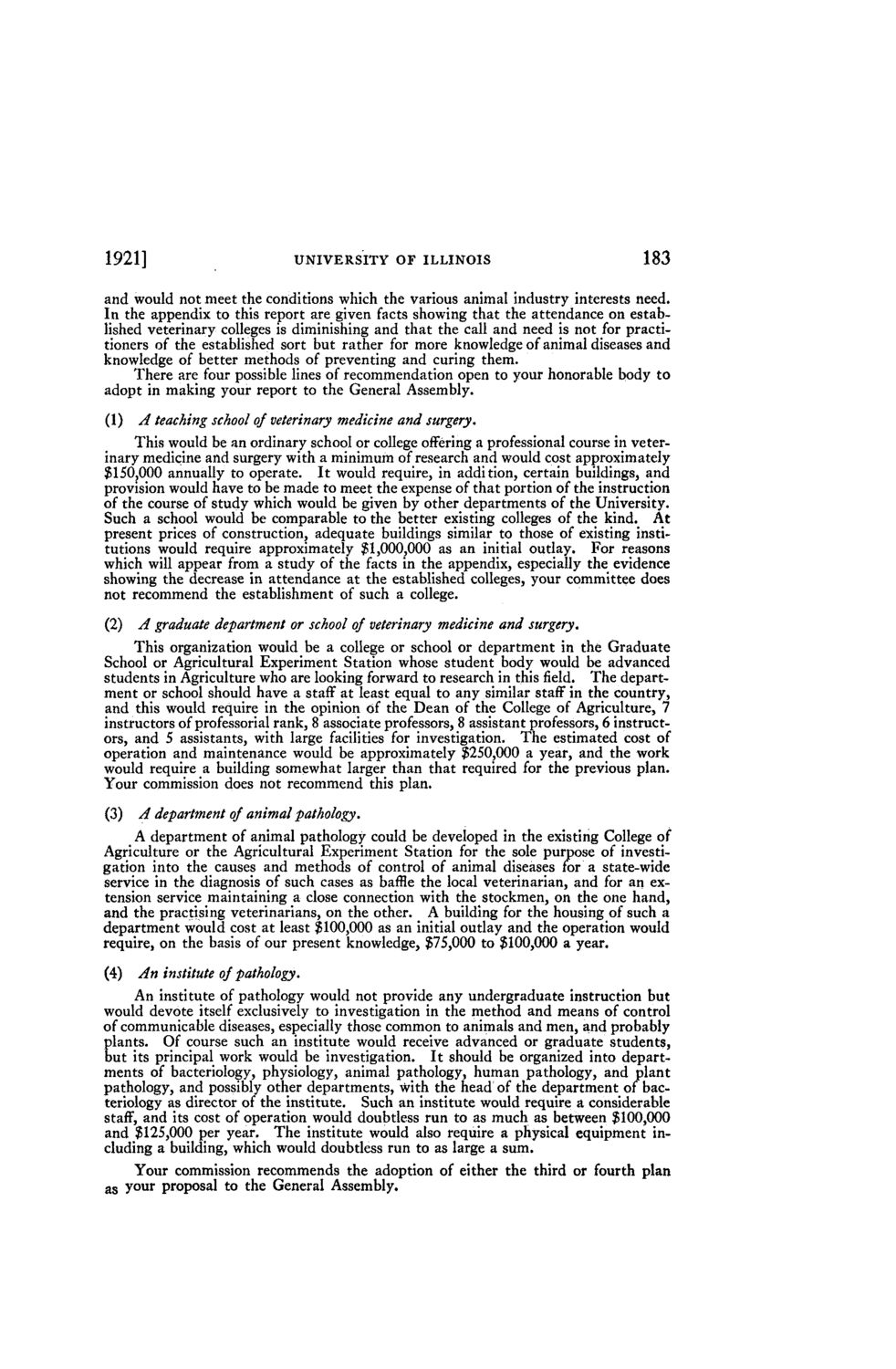| |
| |
Caption: Board of Trustees Minutes - 1922
This is a reduced-resolution page image for fast online browsing.

EXTRACTED TEXT FROM PAGE:
1921] UNIVERSITY OF ILLINOIS 183 and would not meet the conditions which the various animal industry interests need. In the appendix to this report are given facts showing that the attendance on established veterinary colleges is diminishing and that the call and need is not for practitioners of the established sort but rather for more knowledge of animal diseases and knowledge of better methods of preventing and curing them. There are four possible lines of recommendation open to your honorable body to adopt in making your report to the General Assembly. A teaching school of veterinary medicine and surgery. This would be an ordinary school or college offering a professional course in veterinary medicine and surgery with a minimum of research and would cost approximately $150,000 annually to operate. It would require, in addition, certain buildings* and provision would have to be made to meet the expense of that portion of the instruction of the course of study which would be given by other departments of the University. Such a school would be comparable to the better existing colleges of the kind. At present prices of construction, adequate buildings similar to those of existing institutions would require approximately $1,000,000 as an initial outlay. For reasons which will appear from a study of the facts in the appendix, especially the evidence showing the decrease in attendance at the established colleges, your committee does not recommend the establishment of such a college. (2) A graduate department or school of veterinary medicine and surgery. (1) This organization would be a college or school or department in the Graduate School or Agricultural Experiment Station whose student body would be advanced students in Agriculture who are looking forward to research in this field. The department or school should have a staff at least equal to any similar staff in the country, and this would require in the opinion of the Dean of the College of Agriculture, 7 instructors of professorial rank, 8 associate professors, 8 assistant professors, 6 instructors, and 5 assistants, with large facilities for investigation. The estimated cost of operation and maintenance would be approximately $250,000 a year, and the work would require a building somewhat larger than that required for the previous plan. Your commission does not recommend this plan. (3) A department of animal pathology. A department of animal pathology could be developed in the existing College of Agriculture or the Agricultural Experiment Station for the sole purpose of investigation into the causes and methods of control of animal diseases for a state-wide service in the diagnosis of such cases as baffle the local veterinarian, and for an extension service maintaining a close connection with thestockmen, on the one hand, and the practising veterinarians, on the other. A building for the housing of such a department would cost at least $100,000 as an initial outlay and the operation would require, on the basis of our present knowledge, $75,000 to $100,000 a year. An institute of pathology. An institute of pathology would not provide any undergraduate instruction but would devote itself exclusively to investigation in the method and means of control of communicable diseases, especially those common to animals and men, and probably plants. Of course such an institute would receive advanced or graduate students, but its principal work would be investigation. It should be organized into departments of bacteriology, physiology, animal pathology, human pathology, and plant pathology, and possibly other departments, with the head of the department of bacteriology as director of the institute. Such an institute would require a considerable staff, and its cost of operation would doubtless run to as much as between $100,000 and $125,000 per year. The institute would also require a physical equipment including a building, which would doubtless run to as large a sum. as (4) Your commission recommends the adoption of either the third or fourth plan your proposal to the General Assembly.
| |